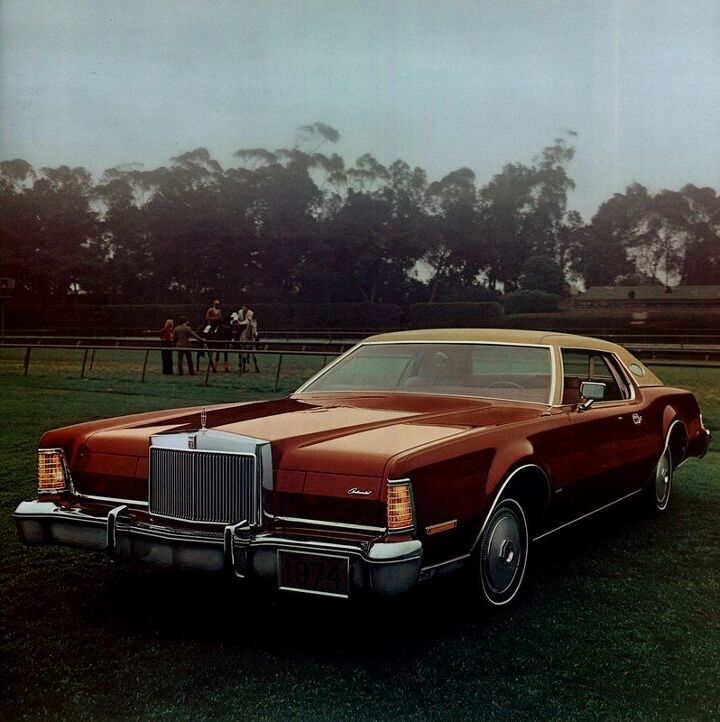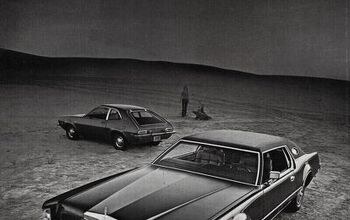Rare Rides Icons: The Lincoln Mark Series Cars, Feeling Continental (Part XIX)

When the Mark IV debuted in 1972, Lincoln’s personal luxury coupe was larger than ever before and had even more in common with its lesser sibling from Ford, the Thunderbird. As noted in our last installment, even the dashboards were identical between the two cars in this generation. The Mark IV’s debut appearance was short-lived, however, as the following year government legislation forced Lincoln’s designers and engineers to make some unfortunate-looking changes. Tell me, do you enjoy enormous bumpers?
The NHTSA wielded its hammer with its first passenger car bumper regulation in 1971. The Federal Motor Vehicle Safety Standard No. 215, “Exterior Protection,” took effect on the first of September, 1972. The NHTSA timed its new law to coincide with car manufacturers’ production of 1973 models. Without getting too deep in the weeds, the law said that in a 5-mile-per-hour crash there could not be functional damage to lighting and fuel system components, at front or rear.
A standard of 2.5 miles per hour was used for rear crash testing for 1973 but was increased to 5 miles per hour in 1974. That meant there was a single model year where large front bumpers were paired with legacy-design rear ends. The legislation meant front-end redesigns for nearly all US market cars in 1973, and also spelled the end of lighting elements integrated into front bumpers in ‘73 and all bumpers in ‘74.
Unfortunately for manufacturers, such integrated lighting designs were popular at the time. The NHTSA’s Exterior Protection standard was supported a month later by Congress, which in October ‘72 enacted the MVICS, or Motor Vehicle Information and Cost Saving Act. The act required the NHTSA to put a bumper standard in place to lower costs to the consumer.
Manufacturers responded with various approaches to their bumper revisions, but almost all of them tended toward bulky designs and additional length for whatever car they were applied to. The additional metal was a cheap way to ensure compliance without redesigning a car in the middle of its production cycle. As far as the Mark IV was concerned, its tidy wrap-under chrome bumper that was similar to that of the Mark III was no more.
In its place was a much heavier chrome bumper which was more vertically oriented. At each corner, the bumper had extended protrusions that provided additional protection to the lighting elements that resided above. At either side of the grille, large vertical bumper guards appeared, offering additional protection in a collision. The cut-out of the bumper that revealed the lower part of the grille was no more.
As far as front-end lighting was concerned, there were only minimal changes in 1973. Indicator lamps grew a bit larger and had a forward-angled look instead of the vertical shape the prior year. There were also new horizontal chrome vanes on the outside of the lamp. Near the front wheels, the cornering lamp moved away from the wheel well and toward the protective corner of the bumper. Since the rear bumper legislation was not fully in effect for ‘73, the Mark IV’s rear did not receive revisions.
Said rear-end transformation arrived the following year with a big, compliant new bumper. And you know what, it was simply not a good look. Much like the front end, the wrap-under bumper design was removed and replaced by a wall of thick chrome. Corner detailing reflected the same protrusions as the front, and there were vertical bumper guards below the tail lamps. Worth noting, Lincoln did not show the rear of the Mark IV in its 1974 brochures.
Mark’s rear end provided more of a challenge than the front with regard to legislation compliance. In 1972 and 1973, all of its rear lighting was integrated into the bumper. None of that would survive an impact at 5 miles per hour, so the trunk lid and rear fenders were redesigned.
Combination brake and reverse lamp assemblies were installed in the rear fender, and extended into the trunk lid area. Placed much higher than before and protected by the bumper, the lighting was a wrap-around style. That meant the red rear side marker could be removed. The former placement of the marker lamp was low on the body, and too close to the bumper to survive a fender bender.
A single ray of positivity happened during the Mark IV’s transformation into ugly regulation duckling: The opera window which was almost always ordered in 1972 became standard for 1973. Elsewhere, the new bumpers and their corresponding extra weight were pushed around by an engine handicapped via EPA regulation. Though the 460 cubic inch (7.5L) V8 was the same mill as in the Mark III, the Mark IV was built in a new era of emissions requirements.
Responding as all manufacturers did, Ford dropped the compression ratio of the 460 to cut emissions. That meant the 365 gross horsepower of the Mark III fell to 212 horsepower in the Mark IV. The drop sounded more substantial as the same year (1972) domestic manufacturers switched horsepower methodology to SAE net. Net figures more accurately reflected horsepower in the real world - the power engines made when actually installed in vehicles.
The emissions era in the Seventies was a sad time for the internal combustion engine, and coupes across the luxury spectrum managed no more than 250 horsepower. That figure was reached by the Series III Jaguar E-Type if equipped with a V12. The Jensen Interceptor was also in the 250-horsepower club, courtesy of the Chrysler 440 (7.2L).
With its gawky appearance, the Mark IV’s sales fell off after they reached a 1973 high of 69,437 examples. The following two years saw sales declines of over 10,000 units, per year. It was almost time for the Mark V to make its debut, but Lincoln massaged the old Mark into a new level of luxury for its final outing. In our next installment, we’ll talk about the exclusive luxury and high-end branding available for a single year: the Continental Mark IV Designer Series.
[Images: Ford]
Become a TTAC insider. Get the latest news, features, TTAC takes, and everything else that gets to The Truth About Cars first by subscribing to our newsletter.

Interested in lots of cars and their various historical contexts. Started writing articles for TTAC in late 2016, when my first posts were QOTDs. From there I started a few new series like Rare Rides, Buy/Drive/Burn, Abandoned History, and most recently Rare Rides Icons. Operating from a home base in Cincinnati, Ohio, a relative auto journalist dead zone. Many of my articles are prompted by something I'll see on social media that sparks my interest and causes me to research. Finding articles and information from the early days of the internet and beyond that covers the little details lost to time: trim packages, color and wheel choices, interior fabrics. Beyond those, I'm fascinated by automotive industry experiments, both failures and successes. Lately I've taken an interest in AI, and generating "what if" type images for car models long dead. Reincarnating a modern Toyota Paseo, Lincoln Mark IX, or Isuzu Trooper through a text prompt is fun. Fun to post them on Twitter too, and watch people overreact. To that end, the social media I use most is Twitter, @CoreyLewis86. I also contribute pieces for Forbes Wheels and Forbes Home.
More by Corey Lewis
Latest Car Reviews
Read moreLatest Product Reviews
Read moreRecent Comments
- Ajla Both parties are in favor of banning Chinese vehicles so I don't see how it won't happen in the next year.
- Add Lightness I don't waste a lot of time watching nothing much happening by watching the YouTube 6 minute highlights.
- MrIcky from my rental fleet experience, id rather drive one of these than a camry.
- Add Lightness Protectionist fear competition under the guise of paranoia.
- Kjhkjlhkjhkljh kljhjkhjklhkjh But facebook, instagram, twitter, your cell phone, your chevy/ford/dodge, your debit card, your credit card selling your data to the SAME OVERSEAS DATABROKERS is ok.Meanwhile parler, telegram literally run on russian hardware is also ''ok''








































Comments
Join the conversation
The 1974 Mark IV brochure did show a side view of the rear end, so the substantially larger bumper was noticeable.
Yes, 1973 had a 5 mph standard for the front and 2.5 mph for the rear, creating in most cases an unbalanced look. However, most cars--including the Mark--slightly modified the rear bumper by either adding bumper guards or extending the 1972 style bumper out just a bit more. That is what Lincoln did for the Mark IV. Thus the car was changed slightly in the rear too. The 1974 model looked less stop-gap, since the rear bumper was protruding like the front. Lincoln also went to the trouble of contouring the big rear bumper on the Mark, whereas the Thunderbird and most other FoMoCo products had bumpers that were big chrome battering rams lacking the styling that CM and Chrysler attempted to add to theirs.